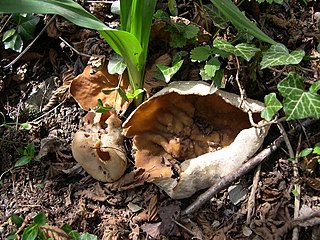Related Research Articles

The Agaricales are an order of fungi in the division Basidiomycota. As originally conceived, the order contained all the agarics, but subsequent research has shown that not all agarics are closely related and some belong in other orders, such as the Russulales and Boletales. Conversely, DNA research has also shown that many non-agarics, including some of the clavarioid fungi and gasteroid fungi belong within the Agaricales. The order has 46 extant families, more than 400 genera, and over 25,000 described species, along with six extinct genera known only from the fossil record. Species in the Agaricales range from the familiar Agaricus bisporus and the deadly Amanita virosa to the coral-like Clavaria zollingeri and bracket-like Fistulina hepatica.

Psilocybe is a genus of gilled mushrooms, growing worldwide, in the family Hymenogastraceae. Most or nearly all species contain the psychedelic compounds psilocybin and psilocin.

Eurotiomycetes is a large class of ascomycetes with cleistothecial ascocarps within the subphylum Pezizomycotina, currently containing around 3810 species according to the Catalogue of Life. It is the third largest lichenized class, with more than 1200 lichen species that are mostly bitunicate in the formation of asci. It contains most of the fungi previously known morphologically as "Plectomycetes".

The Tricholomataceae are a large family of fungi within the order Agaricales. Originally a classic "wastebasket taxon", the family included any white-, yellow-, or pink-spored genera in the Agaricales not already classified as belonging to e.g. the Amanitaceae, Lepiotaceae, Hygrophoraceae, Pluteaceae, or Entolomataceae.

Termitomyces, the termite mushrooms, is a genus of basidiomycete fungi belonging to the family Lyophyllaceae. All of which are completely dependent on fungus-growing termites, the Macrotermitinae, to survive, and vice versa. They are the food source for these termites, who enjoy an obligate symbiosis with the genus similar to that between Atta ants and Attamyces mushrooms.

Roger Heim was a French botanist specialising in mycology and tropical phytopathology. He was known for his studies describing the anatomy of the mushroom hymenium, the systematics and phylogeny of higher fungi, the mycology of tropical fungi such as Termitomyces, as well as ethnomycological work on hallucinogenic fungi, like Psilocybe and Stropharia. In his career, he published over 560 articles, scientific reviews, and major works in fields like botany, chemistry, education, forestry, horticulture, liberal arts, medicine and zoology.

Phaeocollybia is a genus of fungi in the family Hymenogastraceae. They are characterized by producing fruit bodies (mushrooms) with umbonate caps and rough brown spores. The genus is widely distributed, and contains about 50 species. They are known for a long stipe which continues down into the ground, known as a rooting stipe or pseudorhiza formed as the fruitbody grows up from the subterranean colonized roots well below the organic soil layer. The genus is primarily mycorrhizal but may also be somewhat parasitic on forest trees.

Disciotis is a genus of fungi in the family Morchellaceae. Members of this family, characterized by their cup- or bowl-shaped apothecia, have a widespread distribution, especially in northern temperate regions.

Boletellus is a genus of fungi in the family Boletaceae. The genus has a widespread distribution, especially in subtropical regions, and contains about 50 species. The genus was first described by American mycologist William Alphonso Murrill in 1909. The genus name means "small Boletus".
Gigasperma is an inactive genus of fungi in the order Agaricales with a single species. It was treated either as the only genus in the monotypic family Gigaspermataceae, or part of the wider Cortinariaceae. Gigasperma was circumscribed by Austrian mycologist Egon Horak in 1971.

Phlebopus is a genus of fungi in the family Boletinellaceae. The genus has a widespread distribution in subtropical and pantropical regions, and contains 12 species. The species are saprobic, with some possibly able to form mycorrhizae with exotic trees in certain conditions. It contains the gigantic Phlebopus marginatus, the cap of which can reach 1 m (3.3 ft) in diameter.
Phlebonema is a fungal genus in the family Agaricaceae. It is a monotypic genus, containing the single species Phlebonema chrysotingens, described by Roger Heim in 1929 from Madagascar. According to the Dictionary of the Fungi, the placement of this little-known genus in the Agaricaceae is uncertain.
Secotium is a genus of fungi in the family Agaricaceae. The members of this genus are closely related to ordinary Agaricus mushrooms, but do not open out in the usual way; this has given rise to the term "secotioid" for such mushrooms in general. They are thought to form an evolutionary link between agarics and gasteroid fungi. Secotium is a widespread genus, with species that are predominantly found in warm and arid regions.

Psilocybe hoogshagenii is a species of psilocybin mushroom in the family Hymenogastraceae. The mushroom has a brownish conical or bell-shaped cap up to 3 cm (1.2 in) wide that has an extended papilla up to 4 mm long. The stem is slender and 5 to 9 cm long. The variety P. hoogshagenii var. convexa lacks the long papilla.
Endogonopsis is a poorly known fungal genus, provisionally placed in the Diplocystaceae family. A monotypic genus, it contains the single species Endogonopsis sacramentarium, known from southern Asia. It was originally described by French mycologist Roger Heim in 1966.
References
- ↑ Kirk PM, Cannon PF, Minter DW, Stalpers JA (2008). Dictionary of the Fungi (10th ed.). Wallingford, UK: CABI. p. 522. ISBN 978-0-85199-826-8.
- ↑ Heim R. (1968). "Breves diagnoses latinae novitatum genericarum specificarumque nuper descriptarum". Revue de Mycologie. 33 (5): 379–82.